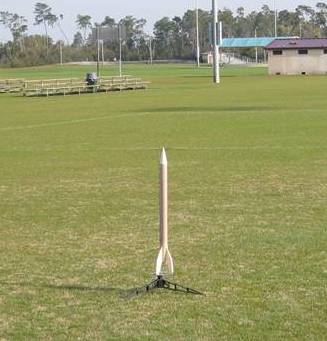Scratch Little Cluster FF Original Design / Scratch Built
Scratch - Little Cluster FF {Scratch}
Contributed by Preston Hoover
| Published: | 2010-04-20 |
| Manufacturer: | Scratch |

Brief:
The Little Cluster FF was inspired by the Estes Big Bertha Kit. I used an eighteen inch BT-60
tube a paper nose cone made form a 4”x6" index card. The fins are the same as the Big Bertha’s. The
engine mount is a double 18 mm mount for a BT-60 tube. I also included a homemade baffle. The Recovery system consists
of an Estes eighteen inch parachute with 125 lb. Kevlar®
string and 1/8” elastic band.
Construction:
- 18" Bt-60 tube
- Baffle for a BT-60 tube
- 4" x 6" index card
- BT-60 double 18 mm engine mount
- 1/8" x 2" launch lug
- 18" plastic parachute
- Small eye screw
- 25" length 125# Kevlar® thread
- 10" 1/8" elastic band
- 4" x 20" x 1/8" sheet of balsa
Step One: Nose Cone Construction.
I used a 4”x6” index card and followed Jimmy Yawn’s instructions for making nose cones. The website is http://www.jamesyawn.com/modelrocket/nosecone/index.html. This is a very strong nose cone and I thought it was fun to make. You could also buy a plastic or balsa nose cone. But that is not scratch building is it? I measured the index card in half and at 1.8 inches to allow for over lap.
Step Two: Baffle Assembly
Assemble the baffle according to the manufacturer’s instructions. Cut a 25” length of 125# Kevlar® thread Drill a small hole, big enough to thread the Kevlar® thread through, each end of the baffle. Make a knot on one end of the Kevlar® thread. Feed the thread through the holes so the knot in on the aft side of the baffle and the free end is forward. Glue knot to baffle. Set aside to dry. Apply a band of glue to the 9” from the forward end of the main body tube. Also apply glue to the baffle rings. Slide the baffle into the main body tube from the aft end until the forward end of the baffle is 9” from the forward end of the tube. Apply glue fillets to the forward and aft end of the baffle. Set aside for glue to dry. !!!Be careful not to glue the Kevlar® thread to the tube. It must remain free!!!
Step Three: Motor Mount Assembly
Assemble the motor mount according to the manufacturer’s instructions. Apply a ring of glue 3.5” from aft end of the body tube. Also apply glue to the centering rings of the motor mount and insert it into the aft end of the body tube allowing the engine hooks protrude from the aft end of tube 1/8”.
Step Four: Fins
Using the pattern supplied cut out three fins from the balsa sheet.
Sand and round the leading and trailing edges as you would any fin. This is also the time to seal your fins if you desire. !!!DO NOT SEAL THE ROOT EDGE!!! It will not stick well to the tube if you do. Mask it or what ever you want to prevent the root edge from being sealed. You can wait until the fins are on the rocket. I prefer to do it this way.
Mark the main body tube for three fins. I used the Estes tube marking tool. Make the lines the whole length of the tube. I used the Estes tube marking guide. Also mark a line the length of the body tube between any two fins. This is for the launch lug. !!!Label your fin and launch lug lines. Glue one fin to each of the fin lines and set aside to dry. When fins are completely dry, apply fillets as you prefer. Glue the launch lug to rocket 8.5” from the top of the tube. Apply glue fillets to the launch lug.
Step Five: Recovery System
Tie one end of the 1/8” elastic cord to the nose cone and the other end to the Kevlar® thread. Put a small dab of glue on the knot. Prepare the parachute according to the manufacturer’s instructions and tie to the nose cone.
Step Six: Painting and Finishing
Finish the rocket by painting it any color you prefer.
Finishing:
There are no special concerns for finishing the rocket. I filled the spirals on the tube.
Sealed the fins and painted it grey.
Flight:
This rocket flies great. I have flown it three times. Twice only one motor ignited. It flew
really straight on one motor. The time it flew on two motors the rocket went approximately 800 ft. Nice flight.
Recovery:
Recovery was normal. The rocket is loaded with a parachute and the home made baffle worked
awesomely. The parachute was not damaged by any exhaust gases.
Summary:
Main thing I like about the rocket is that it is stable on one motor. It looks like a Big
Bertha but has two motors.
Sponsored Ads
 |
 |











